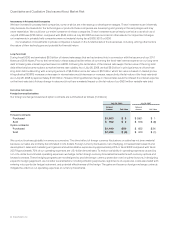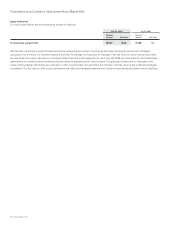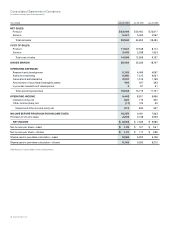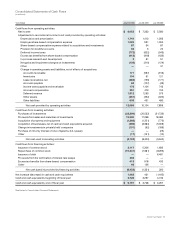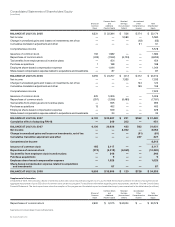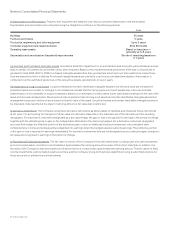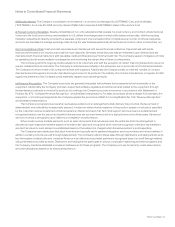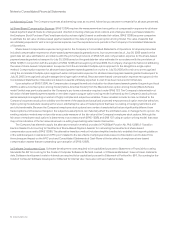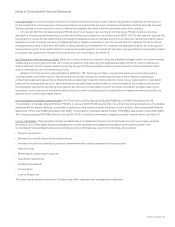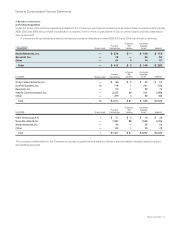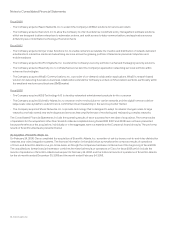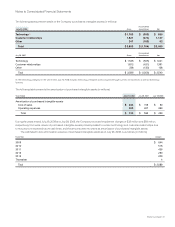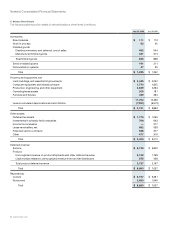Cisco 2008 Annual Report Download - page 48
Download and view the complete annual report
Please find page 48 of the 2008 Cisco annual report below. You can navigate through the pages in the report by either clicking on the pages listed below, or by using the keyword search tool below to find specific information within the annual report.
2008 Annual Report 53
Notes to Consolidated Financial Statements
(k) Minority Interest The Company consolidates its investment in a venture fund managed by SOFTBANK Corp. and its affiliates
(“SOFTBANK”). As of July 26, 2008, minority interest of $49 million represents SOFTBANK’s share of the venture fund.
(l) Foreign Currency Translation Assets and liabilities of non-U.S. subsidiaries that operate in a local currency environment, where that local
currency is the functional currency, are translated to U.S. dollars at exchange rates in effect at the balance sheet date, with the resulting
translation adjustments directly recorded to a separate component of accumulated other comprehensive income. Income and expense
accounts are translated at average exchange rates during the year. Remeasurement adjustments are recorded in other income (loss), net.
(m) Concentrations of Risk Cash and cash equivalents are maintained with several financial institutions. Deposits held with banks
may exceed the amount of insurance provided on such deposits. Generally, these deposits may be redeemed upon demand and are
maintained with financial institutions with reputable credit and therefore bear minimal credit risk. The Company seeks to mitigate such risks
by spreading its risk across multiple counterparties and monitoring the risk profiles of these counterparties.
The Company performs ongoing credit evaluations of its customers and, with the exception of certain financing transactions, does not
require collateral from its customers. The Company’s customers are primarily in the enterprise, service provider, and commercial markets.
The Company receives certain of its components from sole suppliers. Additionally, the Company relies on a limited number of contract
manufacturers and suppliers to provide manufacturing services for its products. The inability of a contract manufacturer or supplier to fulfill
supply requirements of the Company could materially impact future operating results.
(n) Revenue Recognition The Company’s products are generally integrated with software that is essential to the functionality of the
equipment. Additionally, the Company provides unspecified software upgrades and enhancements related to the equipment through
its maintenance contracts for most of its products. Accordingly, the Company accounts for revenue in accordance with Statement of
Position No. 97-2, “Software Revenue Recognition,” and all related interpretations. For sales of products where software is incidental to the
equipment, or in hosting arrangements, the Company applies the provisions of Staff Accounting Bulletin No. 104, “Revenue Recognition,”
and all related interpretations.
The Company recognizes revenue when persuasive evidence of an arrangement exists, delivery has occurred, the fee is fixed or
determinable, and collectibility is reasonably assured. In instances where final acceptance of the product, system, or solution is specified
by the customer, revenue is deferred until all acceptance criteria have been met. Technical support services revenue is deferred and
recognized ratably over the period during which the services are to be performed, which is typically from one to three years. Advanced
services revenue is recognized upon delivery or completion of performance.
When a sale involves multiple elements, such as sales of products that include services, the entire fee from the arrangement is
allocated to each respective element based on its relative fair value and recognized when revenue recognition criteria for each element
are met. Fair value for each element is established based on the sales price charged when the same element is sold separately.
The Company uses distributors that stock inventory and typically sell to systems integrators, service providers, and other resellers. In
addition, certain products are sold through retail partners. The Company refers to these sales through distributors and retail partners as its
two-tier system of sales to the end customer. Revenue from distributors and retail partners is recognized based on a sell-through method
using information provided by them. Distributors and retail partners participate in various cooperative marketing and other programs, and
the Company maintains estimated accruals and allowances for these programs. The Company accrues for warranty costs, sales returns,
and other allowances based on its historical experience.



